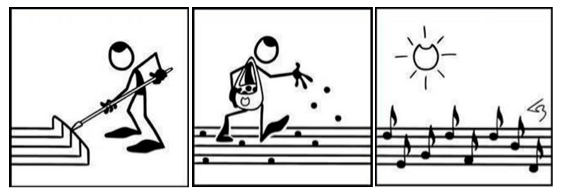by Malu Sciamarelli
“Music is the electrical soil in which the spirit lives, thinks and invents.”
(Ludwig van Beethoven)
A long time ago, my father taught me a powerful kind of magic: watch and listen to all the images and sounds of the world. This magic gave me the ability to make stories come to life and bring them to my classes, share with my students so that they too can come alive, blossom and create their own stories, express their own music and make their own magic their own way.
Why are stories and music so important in the classroom? I believe they are a nurturing way to remind students of all ages and levels that words are powerful, that listening is important and that communication between people is an art.
As a learning tool, music and stories can encourage students to explore their unique expressiveness and can intensify a student’s ability to communicate thoughts and feelings in a coherent and clear manner. They can encourage students to use their imagination. Developing imagination can empower students to consider new and inventive ideas; contribute to self-confidence and personal motivation as students envision themselves competent and able to accomplish their hopes and dreams. These benefits transcend the art experience to support daily life skills.
The use of stories and music in the classroom can also set the scene and create a learning atmosphere to enhance our teaching and learning activities. Besides, they make the process more fun and interesting! They also affect our feelings and energy levels – to create moods that we desire, to make us happy, to energize, to bring back powerful memories, to help us relax, focus, express our creativity – sometimes in the form of a drawing or painting – and to share it with the world around us.

I have been using music and stories with very young, teen and adult students, and I can clearly see an increase in lesson effectiveness and in my students’ joy of learning. I integrate music and stories in my classes in different ways and with different purposes:
- To learn information
Music increases interest and activates the information mentally, physically or emotionally, helping create learning states which enhance understanding. I play music with an association to the topic of a specific lesson, before starting it or sometimes during parts of that lesson or while reading a story and it has helped my students remember information. Playing music during parts of the lesson also helps students stay more alert while reading or working on projects.
Teaching through songs, chants, poems and stories improves memory of content facts and details. My students learn vocabulary and construct personal values, for example, by using music and stories that are presented to them, and many times they are encouraged to write their own music and stories.
- To create a welcoming atmosphere and develop a sense of community and cooperation
Music and stories have a great effect upon students’ attitude and motivation to learn. By creating a positive learning atmosphere they welcome students to participate in the learning experience. I usually play background music, or read a story as my students enter the classroom or as they leave and it totally changes the atmosphere: lagging attention levels are energized or students are soothed and calmed when necessary, depending on the music and story that is used. Music and stories also help to develop a sense of community and cooperation. I use music and stories to create group activities or to develop classroom rituals and it help us experience ways to build lasting and memorable community experiences within my groups.
- To enhance creativity and reflection
I love using background music in my classes and I can see that it stimulates creativity and encourages personal reflection. I once tried an activity with two groups of the same level where at the end of the process, students had to write a story. The group in which I used background music related to the theme of the writing was much more creative and wrote much more than the group in which music was not used. I could also see that with music, I could hold students’ attention for longer periods of time.
Having shared all the reasons I believe music and stories should be used in the classroom and having given some practical uses of them, where can the magic be found in all these processes?
Music and stories are the doorways to inner realms in which we can express ourselves in writing, art and all kinds of projects. The magic happens when students believe they can do it, when they believe in themselves. By believing, they can make anything happen…yes, even by magic!
http://www.redhongyi.com/gerald
If you want to know where my stories come to life, you can read it here: http://www.teachingvillage.org/2013/02/12/where-do-your-stories-come-to-life-by-malu-sciamarelli/
and if you want to read the first of the series “Stories from the Garden”, here’s the link: http://www.teachingvillage.org/2013/05/09/the-little-girl-and-the-magic-words-malu-sciamarelli/
More about the artist Red/Yong Yi can be found here: http://www.redhongyi.com and singer/songwriter Yuna: http://www.yunamusic.com
Connect with Malu and other iTDi Associates, Mentors, and Faculty by joining iTDi Community. Sign Up For A Free iTDI Account to create your profile and get immediate access to our social forums and trial lessons from our English For Teachers and Teacher Development Courses.



